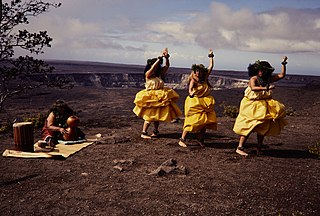 W
WThe Āhole Hōlua Complex is a hōlua slide located on Āhole Inlet on the southwest side of the island of Hawaii. The slide was used in the Native Hawaiian sport of hōlua, in which upper-class men raced toboggans down lava slides covered in slippery grasses. Stone platforms along the side of the slide allowed spectators to watch the races. The slide consists of a 60 metres (200 ft) slope and a 23 metres (75 ft) runway; the slope and length of the slide indicate that the Native Hawaiians had developed advanced engineering skills. The slide is among the best-preserved hōlua slides in Hawaii.
 W
WThe Aloha Festivals are an annual series of free cultural celebrations observed in the state of Hawaii in the United States. It is the only statewide cultural festival in the nation. Highlights include the presentation of the Royal Court, a ho'olaule'a in Waikiki, and the Floral Parade. Approximately 30,000 people volunteer to plan, organize, and provide labor for the Aloha Festivals each year. Their efforts entertain over 1,000,000 people from throughout the state and visitors from all over the world.
 W
WThe Hawaiian Poi Dog is an extinct breed of pariah dog from Hawaiʻi which was used by Native Hawaiians as a spiritual protector of children and as a source of food.
 W
WThe Hawaiian Renaissance was the Hawaiian resurgence of a distinct cultural identity that draws upon traditional kānaka maoli culture, with a significant divergence from the tourism-based culture which Hawaiʻi was previously known for worldwide. The Hawaiian Renaissance has been pointed to as a global model for biocultural restoration and sustainability.
 W
WThe Hokukano-Ualapue Complex is a National Historic Landmarked pre-contact archaeological site on several properties adjacent to Hawaii Route 450 in Ualapue, on Molokaʻi island. The complex includes six heiaus and two fishponds. The complex is one of the most important collections of native Hawaiian sites in Hawaiʻi. It was designated a National Historic Landmark in 1962 and added to the National Register of Historic Places on October 15, 1966.
 W
WJohn Dominis Holt IV was a Native Hawaiian writer, poet and cultural historian. In 1979, he was recognized as a Living Treasures of Hawaiʻi for his contribution to the Hawaiian Renaissance.
 W
WLapakahi State Historical Park is a large area of ruins from an Ancient Hawaiian fishing village in the North Kohala District on the Big Island of Hawaiʻi. Offshore is the Lapakahi Marine Life Conservation District.
 W
WMicrolepia strigosa, known as hay-scented fern, lace fern, rigid lace fern and palapalai, is a fern indigenous to the Hawaiian islands and is also native to other parts of the tropics and subtropics including India and Malaysia. This fern belongs to a group of about seventy Microlepia species in the bracken or hay-scented fern family (Dennstaedtiaceae). There are two indigenous species and a hybrid found in the main Hawaiian Islands. It is also known by the botanical names: Davallia hirta, Davallia setosa, Davallia strigosa, Dicksonia kaulfussiana, Dicksonia strigosa, Microlepia hirta, Microlepia setosa, Stenoloma tenuifolium, Trichomanes strigosum. It has coarse, light to medium green fronds which can grow to more than 3 ft (0.9 m) long.
 W
WThe Puna-Kāʻu Historic District is an archaeological district located on the Puna-Kāʻu coastline in Hawaii Volcanoes National Park. The district includes over 300 sites occupied by Polynesians from the 13th through 19th centuries. Eleven of the sites within the district are considered exceptionally significant to modern understanding of native Hawaiian culture and have been the focus of most archaeological research in the area. Five of these sites are villages, at Poupou-Kauka, Kailiili, Kamoamoa, Laeʻapuki, Keahou Landing; these village sites provide insight into the agricultural and social practices of the Polynesians. The Puna-Kāʻu coastal trail, another one of the significant sites, connected these villages and provided a link to communities in the mountains. The remaining sites include the Wahaulu Heiau temple, the Puuloa petroglyph site, a pulu factory, and two shelter sites used by fishermen and opihi pickers.
 W
WPāʻani Hawaiʻi or Pāʻani for short, are Hawaiian play, games, and contests. Most pāʻani Hawaiʻi place pertinence on language and chanting as part of the pāʻani, excepting only lele koali, a Hawaiian swinging game based around either a koali vine or a koali hao. Manaleo “Aunty” Alice in her Ka Leo Hawaiʻi interview stated that an exchange of words and play spans either a few days or a whole week during lele koali. During this time, everybody gathers to socialize, tell stories, play music, and share meals. Pāʻani Hawaiʻi has been compared in anthropological study to Japanese games.